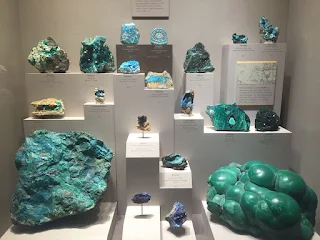What is Turquoise?
Turquoise is a sky-blue or green translucent to opaque basic aluminium phosphate that contains copper. Turquoise is the birthstone of December. People have liked it for a long time because of its pretty colour. It's often used to make jewellery and art, especially by Native Americans. Turquoise is made of copper and aluminium and is usually found near copper. Its bright colour reminds people of calm water or green plants.
History of Turquoise
Turquoise was used by the ancient Egyptians and Aztecs as a jewellery gemstone and decorative stone. King Tutankhamun's burial mask and tomb were inlaid with turquoise. The ancient Egyptians believed that the colour blue was a symbol of regeneration, so turquoise was treasured for both decorative and superstitious purposes. The Mesoamericans created turquoise mosaics and the Chinese carved turquoise into ornaments. Turquoise was also used by Native Americans in works of art and jewellery, some of whom believed that it possessed protective properties. The Tibetans believe in the healing properties of turquoise and have valued turquoise jewellery for centuries.
Where can you find Turquoise?
Turquoise occurs as botryoidal (grape-like) masses or nodules in fissures. The best quality turquoise is located in Northeast Iran. Turquoise deposits are also found in Afghanistan, Argentina, Australia, Brazil, China, Israel, Mexico, Tanzania and the USA.
Types of Turquoise in Terms of Color Variance
Blue Turquoise
Blue turquoise is highly sought after for its striking colour and visual appeal, encompassing shades ranging from pale sky blue to deep, intense hues. Historically mined in regions like Persia (Iran) and the Sleeping Beauty mine in Arizona, it's valued for its origins and quality. While some varieties are relatively free of matrix, others feature intricate patterns in contrasting colours. Highly prized in the gemstone market, turquoise with minimal matrix and even colouration commands a premium. With cultural significance, especially among Native American tribes, blue turquoise symbolizes wisdom and protection, making it a cherished gemstone worldwide.
Green Turquoise
Green turquoise, prized for its lush green hues, encompasses a spectrum ranging from soft mint to rich emerald tones. Sourced globally, notable producers include China, with mines yielding stones in various shades. Green turquoise may feature matrix patterns, adding character, with colours like brown or black complementing the greens. Highly valued in the gemstone market, stones with vibrant, consistent colouration command premium prices. Symbolizing growth and renewal, it holds cultural significance, making it popular for jewellery and art. Some stones undergo treatments for colour enhancement or stability. Green turquoise's timeless appeal and symbolic meaning make it a cherished gemstone worldwide.
Blue Green Turquoise
Blue-green turquoise, found globally in regions like the southwestern United States, Iran, China, and Africa, blends blue and green hues to create a visually striking gemstone. With matrix patterns adding depth and colour ranging from turquoise to teal, it's highly valued for its vibrant colour and cultural significance.
Robin's Egg Blue Turquoise
"Robin's Egg Blue Turquoise" likely refers to a turquoise stone or material that has a shade reminiscent of the soft blue colour of Robin's eggs. It combines the colour of robin's egg blue with the texture or appearance of turquoise. This could be a particular variety of turquoise that exhibits this specific shade, or it could refer to a material or product that mimics the colour of Robin's egg blue using turquoise as an inspiration.
Famous Turquoise Pieces and Collections
The Duchess of Windsor's Turquoise Collection: Wallis Simpson, the Duchess of Windsor, was known for her extensive jewellery collection, which included several pieces featuring turquoise. One notable item is a turquoise and diamond necklace designed by Cartier.
The Queen of Iran Turquoise Collection: Empress Farah Pahlavi of Iran amassed an impressive collection of turquoise jewellery during her reign. The collection includes elaborate necklaces, bracelets, and earrings adorned with turquoise and other gemstones.
The Smithsonian's National Gem Collection: The Smithsonian Institution in Washington, D.C. houses a vast collection of gemstones, including several pieces featuring turquoise. One notable example is the "Dom Pedro" aquamarine and turquoise carving, which is one of the largest gem carvings in the world.
 |
| Photo Copyright ©️ pinterest.com |
Tags:
Turquoise








